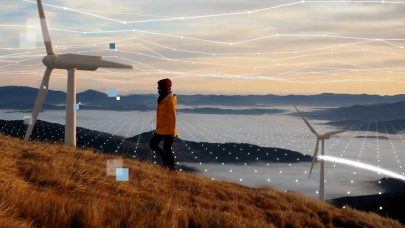In 2022, Intel pledged to reduce greenhouse gas emissions in its operations and across the value chain. As part of this pledge, Intel is focused on achieving 100% renewable energy, net-positive water and zero waste to landfills by 2030. Reducing a carbon footprint isn’t easy, so Intel is collaborating with industry and academia, particularly the high-performance computing (HPC) community, to identify, develop and pilot alternative green chemistry and abatement solutions, many of which do not exist today. Intel’s current roadmap targets driving reductions and ultimately achieve net-zero greenhouse gas emissions (Scope 1 and 2) across our global operations by 2040.
 Massive data centers with thousands of processors require significant electricity to run properly. Keeping the chips cool consumes even more energy. Following are considerations for creating a more efficient, sustainable future in AI and HPC:
Massive data centers with thousands of processors require significant electricity to run properly. Keeping the chips cool consumes even more energy. Following are considerations for creating a more efficient, sustainable future in AI and HPC:
- Invest in newer technologies: The newest Intel technologies are designed to deliver higher performance and energy efficiency across a wide range of AI (training and inference) and HPC workloads. For example, 4th Gen Intel® Xeon® processors are Intel’s most sustainable data center processors to date. With built-in accelerators, like Intel® Advance Matrix Extensions (Intel® AMX), performance increases of 10x can be achieved across a broad suite of AI workloads and use cases1 while also enabling up to 14x performance-per-watt increases over Intel’s previous generation.2 Additionally, Intel® Xeon® CPU Max Series processors use 68% lower power while providing the same performance as compared to competition.3 And Intel’s Habana® Gaudi®2 GPUs have demonstrated power efficiency when running a popular computer vision workload, showing a 1.8x advantage in throughput-per-watt over a comparable competitor-based server.4
- Consider liquid cooling options: Modern liquid cooling approaches, such as immersion, can lower a data center’s power usage effectiveness (PUE) from an average of 1.3 to results as low as 1.03 and reduce its electricity consumption by up to 30 percent5. The added cooling capability also allows data center managers to achieve up to 10X higher system density in the same-sized rack5. Additionally, water is a scarce resource, and cooling data centers with other engineered liquids can significantly reduce water use6.
- Go open source for power management: Intel supports the Global Extensible Open Power Manager framework, called GEOPM, an open-source model for exploring power and energy optimizations targeting heterogeneous platforms. GEOPM has been developed to enable efficient power management and performance optimizations. With this powerful open-source framework, users can monitor their system’s energy consumption and safely optimize system hardware settings to help achieve energy efficiency or performance objectives. Intel’s testing of GEOPM for HPC clusters shows power savings of up to 20% with no or minimal performance degradation (less than 2%) on select workloads.7
- Partner with technology vendors prioritizing improved manufacturing sustainably: Many major tech companies are leading this charge and have already committed to shrinking their carbon footprint in manufacturing. Intel’s use 93% renewable electricity worldwide is an example of the progress in reducing the carbon footprint of processors. In addition, Intel has made significant progress in water reduction by conserving 9.6B gallons of water in 2022 and achieving net positive water in the US and India. Intel has also achieved significant waste reduction with only sending 6.4% of waste to the landfill and recycling 67% of manufacturing waste.
While much work remains to reach its environmental and sustainability goals, Intel has made demonstrable progress and continues to work with industry partners and the HPC community to create a more sustainable compute future. This commitment, matched with the innovations Intel is enabling in high performance computing, gives customers a significant advantage in compute power and efficiency for accelerating AI, the cloud, and the world’s most powerful supercomputers. Read more about Intel’s corporate responsibility and sustainability commitments in its RISE Strategy and Goals.
Notices and Disclaimers
1Learn more at www.Intel.com/PerformanceIndex under Intel® Xeon® Processors, 4th Ge Intel® Xeon® Scalable Processors. Claim A16
2See intel.com/processorclaims: 4th Gen Intel Xeon Scalable processors. Claim E1
3Visit the Supercomputing 22 page at intel.com/performanceindex for workloads and configurations. Results may vary.
4Supermicro L12 Validation Report of Gaudi2 HL-225H SYS-820GH-THR2, Oct. 20, 2022
5https://grcmain.wpenginepowered.com/wp-content/uploads/grc_comparing_data_center_cooling_technologies_comparison_ebook.pdf
6https://liquidstack.com/white-papers/data-centers-could-save-300-billion-liters-water
7https://link.springer.com/content/pdf/10.1007/978-3-319-58667-0_21.pdf
Performance results are based on testing as of dates shown in configurations and may not reflect all publicly available updates. Intel does not control or audit third party data. You should consult other sources to evaluate accuracy. Intel technologies may require enabled hardware, software, or service activation.



























































